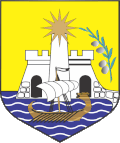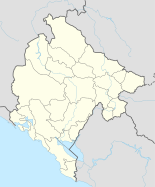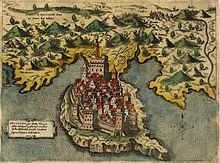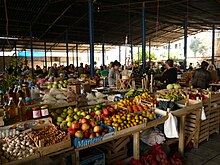Ulcinj
|
Ulcinj Улцињ Ulqin / Ulqini |
||||
|
||||
| Basic data | ||||
|---|---|---|---|---|
| State : |
|
|||
| Municipality : | Ulcinj | |||
| Coordinates : | 41 ° 55 ' N , 19 ° 12' E | |||
| Height : | 20 m. i. J. | |||
| Area : | 255 km² | |||
| Residents : | 10,707 (2011) | |||
| Population density : | 42 inhabitants per km² | |||
| Telephone code : | (+382) 030 | |||
| Postal code : | 85360-85362 | |||
| License plate : | UL | |||
| Structure and administration (status: 2018) | ||||
| Mayor : | Loro Nrekiq ( DPS ) | |||
| Postal address : | Bulevard Gjerg Kastrioti Skenderbeu pn 85360 Ulcinj |
|||
| Website : | ||||
Ulcinj is the southernmost city in Montenegro . It is located in the municipality of the same name on the Adriatic Sea and near the border with Albania .
Ulcinj has a beautiful old town. In the immediate vicinity is the “small city beach” ( Mala Plaža in Montenegrin , Plazh i Vogël in Albanian ). The cityscape shows the Ottoman past, numerous mosques such as the church mosque and the Namazgjahu mosque are spread over the whole city.
Surname
Ulcinj ( Montenegrin - Cyrillic Улцињ ) is the current name of the city in the Montenegrin or Serbian , Bosnian and Croatian languages . In Albanian - which is also the official language of the municipality - it is called Ulqin in the indefinite form of the name or Ulqini in the definite form. In Italian it is called Dulcigno , in Turkish Ülgün .
The place name goes back to the ancient name Ulcinium , from which Lьcinь and then Ocinj were formed in Old Serbian . The current Slavic form of the name Ulcinj , however, arose from the influence of the Albanian name. The initial d - in Dulcigno comes from a fusion with the preposition de ("from").
history
The first inhabitants of the Ulcinj area known by name were the Illyrians . In ancient times there was a settlement of Greek colonists who - archaeological excavations have shown - in the 5th century BC. Was expanded to the city. During the Hellenistic period, the place was under the influence of the various short-lived Illyrian kingdoms and came under the influence of 163 BC. BC as Olcinium (= city of the Olcinjaten, an Illyrian tribe) under Roman rule. Under this name, Ulcinj is mentioned in writing for the first time by Pliny the Elder in the Naturalis historia . During the Roman rule, Ulcinj was a fortified settlement of Roman citizens. It had the status of an oppidum civium Romanorum and later became a municipium - that is, an independent city under Roman law.
After the division of the Roman Empire , Ulcinj and the province of Praevallis fell to Ostrom and the inhabitants adopted Christianity . In late antiquity, Ulcinj was the seat of a bishopric; the diocese existed with interruptions until the beginning of Turkish rule in the 16th century.
Ulcinj belonged to the Serbian empires Duklja and Raszien in the 9th and 10th centuries and then again in the 12th century, and briefly also to the Nemanjid state. It became an important trading and maritime center of the Serbian state. After 1355 the Balšići took control of the city. Ulcinj was repeatedly under Venetian rule, but most of the time the city was de facto independent. Its inhabitants, the "Dulcinoten" (Italian), were feared pirates in the Adriatic. From 1571 to 1880 Ulcinj was part of the Ottoman Empire . A siege by Venetian troops - at sea and on land - that began in 1718 under Field Marshal Johann Matthias von der Schulenburg was lifted again due to the Peace of Passarowitz . Through the slave trade, especially in the 18th and 19th centuries, some blacks came to the city and - when they were free - settled there, so that a community of black people emerged in the city, which almost completely disappeared after the end of Ottoman rule .
During the war with the Ottoman Empire, Montenegro captured Ulcinj on January 20, 1878. At the conclusion of the preliminary peace of San Stefano , Ulcinj was again granted the Sublime Porte by the Russians , while Montenegro only got a few villages on Lake Shkodra . The Berlin Congress revised the San Stefano agreements also with regard to Ulcinj and awarded the city of Montenegro. The Ottoman Empire refused to vacate the city. Only after the intervention of the great powers, including a joint fleet demonstration off the Turkish coast, did the Ottomans give in. On November 30, 1880 Ulcinj was finally annexed to the Principality of Montenegro .
Since 2008 Ulcinj has been the district partner town of the 23rd Viennese district Liesing . The corresponding written agreement was preceded by four years of cultural and infrastructural cooperation with the southernmost municipality of the Austrian capital.
population
According to the 2011 census, the city has 10,707 people. Another 9,214 people live in the surrounding villages, which results in a population of 19,921 for the entire municipality of Ulcinj.
Of them, 14,076 (70.66%) describe themselves as Albanians , 2,478 (12.44%) as Montenegrins , 1,145 (5.75%) as Serbs , 780 (3.92%) as ethnic Muslims , 449 (2.25 %) as Bosniaks and 232 (1.17%) as Roma and Balkan Egyptians . There are also other smaller population groups living in the community, and some of the respondents gave no answer regarding ethnic group.
| census | 1948 | 1953 | 1961 | 1971 | 1981 | 1991 | 2003 | 2011 |
|---|---|---|---|---|---|---|---|---|
| Residents | 4385 | 4919 | 5705 | 7459 | 9140 | 11,144 | 10,828 | 10,707 |
tourism
Ulcinj is a well-developed tourist city with a large number of hotels and guest houses. Outside the city begins the "Big Beach" (in Montenegrin Velika Plaža / Albanian Plazhi i madh ), which extends to the Albanian border with a length of 13 kilometers. This makes it the longest sandy beach on the eastern Adriatic coast. This also includes the nudist area on the island of Ada at the mouth of the Bojana River . Before the Yugoslav Wars, Ulcinj was a popular travel destination for Germans, Italians, French and English.
Albanians from Kosovo have made up a large part of the tourists in Ulcinj, especially since the 1990s. The Diaspora Albanians also appreciate Ulcinj as a holiday destination to this day.
sons and daughters of the town
- Mujo Ulqinaku (1896–1939), Albanian national hero
- Hajro Ulqinaku (* 1938), Albanian writer
- Kaplan Burović (* 1934), Albanian writer and journalist
- Adrian Lulgjuraj , Albanian singer
literature
- Peter Bartl: The Dulcignotes. Piracy and merchant shipping in the Adriatic (18th century) . In: Southeastern Europe under the half moon. Studies on the history and culture of the Southeast European peoples during the Turkish period. Dedicated to Prof. Georg Stadtmüller on the occasion of his 65th birthday . Munich 1975, pp. 17-27.
Web links
- Ulcinj City Information (English)
- Multilingual information site about Ulcinj
- UlcinjToday South Coast Montenegro (English)
Individual evidence
- ↑ Loro Nrekiq, kryetar i ri i Ulqinit. In: Koha. June 9, 2018, accessed August 22, 2018 (Albanian).
- ↑ Ulcinj. In: mirjanadetelic.com. Retrieved May 7, 2018 (Serbian).
- ↑ Mustafa Canka: Only Memories and Emptiness Remain: The History of Ulcinj's Afro-Albanian Community in Montenegro. In: LeftEast , September 30, 2013 (English).
- ↑ Peter Bartl: Albania. From the Middle Ages to the present . Pustet, Regensburg 1995, ISBN 3-7917-1451-1 , p. 98.
- ^ Vienna City Hall correspondence of October 28, 2008
- ↑ a b Popis stanovništva, domaćinstava i stanova u Crnoj Gori 2011. godine. (PDF) In: monstat.org. Statistics Office of Montenegro, July 12, 2011, accessed on August 13, 2016 (Serbo-Croatian / English, for the sake of clarity, several entries from the census are summarized here for the groups “ethnic Muslims” and “Muslims” (religion)).
- ↑ Montenegro censuses. In: pop-stat.mashke.org. Retrieved May 11, 2018 .
- ↑ Hajro Ulqinaku. In: www.ulqini.de. Retrieved April 27, 2016 .





